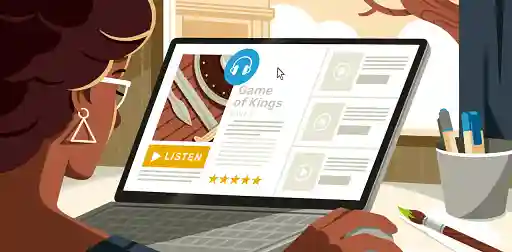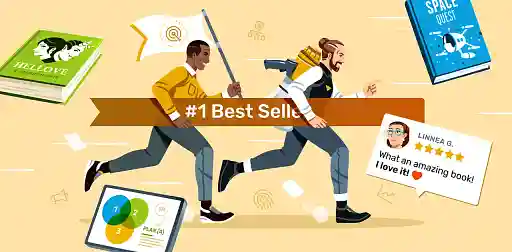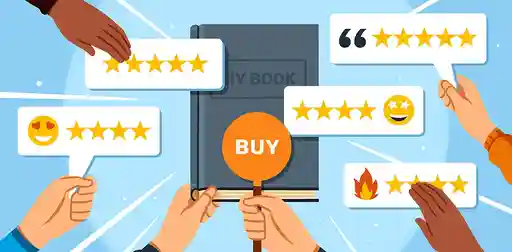Posted on May 07, 2021
Social Media for Writers: The Complete Guide
About the author
Reedsy's editorial team is a diverse group of industry experts devoted to helping authors write and publish beautiful books.
More about the Reedsy Editorial Team →Savannah Cordova
Savannah is a senior editor with Reedsy and a published writer whose work has appeared on Slate, Kirkus, and BookTrib. Her short fiction has appeared in the Owl Canyon Press anthology, "No Bars and a Dead Battery".
View profile →Social media has become part of our daily lives: we scroll through Twitter for the latest hot takes, check Instagram for our friends’ Stories, click over to Facebook for more updates, rinse and repeat. Naturally, it’s one of the places to be if you’re an author who wants to establish your brand, promote your work, and connect with readers and fellow creatives!
In this all-inclusive guide to social media for writers, we’ll cover everything you need to know: how to choose which platform(s) to prioritize, build your following, and ultimately use social media to promote your title. Of course, book marketing isn't just social media — to go beyond that scope, we recommend downloading this book marketing checklist to make sure that you're ticking off all of the other boxes.

FREE RESOURCE
Reedsy’s Book Marketing Checklist
Tick all the boxes, from ads to networking to social media and beyond.
But for now, let’s start with the question of which platform, then go on to provide detailed tips and case studies from authors who have used each of them successfully.
Which platform(s) should you choose?
As Ricardo Fayet notes in his 2021 guide How to Market a Book: Overperform in a Crowded Market, a key tenet of book marketing is not trying to do everything. Instead, focus on just one or two effective marketing channels. This is especially relevant to social media, which offers so many platforms for different audiences.
So how do you pick the best social platforms for you as a writer? First and foremost, consider your intended reader. Where are they most likely to “hang out” on the Internet?
👍🏽 Facebook remains the most popular social network in the world, with nearly 200 million active users in the US. Its core user base is young, perhaps surprisingly so (65% under 35), and skews male (57%). Data also suggests that about half of Facebook users belong to a Facebook Group, which is good for authors who wish to market this way — and as we discuss below, it’s also one of the best platforms for author ads.
🤳 Instagram has 120 million active users in the US, 70% of whom are under 35, with an even gender split. Perhaps most notably for those looking to build an enthusiastic following, Instagram engagement is through the roof — 1% across all industry brands (which might seem low, until you compare it to Facebook’s 0.25% and Twitter’s 0.08%).
🖼 Pinterest, the other big image-sharing platform, has about 100 million users in the US. A whopping 30.4% of these users are women aged 25-34 — for context, this group makes up about 17% of Instagram users and 13% of Facebook users. If that’s your target audience, do keep Pinterest in mind.
🐦 Twitter has fewer active users than the other major platforms here — 68 million in the US, about 62% male — as it’s primarily meant for sharing news and ideas, rather than as a purely social app. But it boasts a dedicated user base and is very popular among writers, who tend to prefer platforms that focus on the written word.
Other factors to consider
All that said, numbers aren’t everything. You should also think about which platform(s) would best serve your author “brand”, as well as how you like to connect with people online.
To get a sense of the former, look at writers and authors similar to you. Which platforms do they belong to, what kind of content do they post, and what is their engagement like? Be sure to follow them if you haven’t already! Not only can they inspire your content, but interacting with them may help you increase your own follower count.
As for the second, the platforms you currently belong to are a good clue. Do you like sharing photos and fun graphics on Instagram? Do you enjoy spirited discourse on Twitter? See yourself getting involved in Facebook Groups to gain readers? Though personal preference isn’t as important as access to your target audience, it could be the deciding point if you’re stuck.
And so long as you don’t focus all your efforts on a platform that’s totally incongruous with your work — for example, spending ten hours a day on Pinterest when you’re writing a dense history book for retired men — there are always ways to optimize a platform for your purposes.
Which is exactly what we’ll be talking about next! Feel free to skip ahead to your platform of choice using the table of contents to your left. Otherwise, enjoy the social extravaganza 👩🏻💻
Facebook for authors

By far the biggest social network in the game, Facebook is an excellent choice for writers who want all the spacious content of their own web domain without having to maintain it independently — or who already have plenty of friends on Facebook who they can channel into this new effort.
You can certainly promote yourself and your work from your personal Facebook account, but Facebook makes it easy to create a specialized Author Page or Facebook Group for your fans. To do this, click the + symbol in the upper-right corner of Facebook and select which one you want:
- An Author Page is what most writers have. This allows you to write posts, add photos and videos, and create a sidebar that stays with users as they scroll — basically, the Facebook equivalent of an Author Page on Amazon. Fans can “like” and follow your page for updates, comment on posts, and even message you, but they can’t post content on the page itself.
- If you’d like to foster more of a community spirit, consider creating a Facebook Group. With a Group, your followers can post their own content, which allows them to forge stronger connections with one another. The downside is that you’ll have to moderate everything that’s posted, which can be difficult to manage even with a small following!
In short: we’d recommend creating an Author Page, but feel free to try a Group if your followers are engaged enough to keep it active (and you have time to moderate it). Whichever way you go, here are some more tips to help you get the most out of Facebook as a writer.
Tips for authors on Facebook
🤔 Post thoughtful, long-ish content. Mixing blog-like posts with short status updates seems to work well for most Facebook users. Talk about your day, your new projects, and so on — keep it personal, interesting, and not too long (200-300 words is plenty).
Not quite sure how to approach writing for social media? Perhaps these tips on how to write better can give you a head start.
🔗 Take advantage of link sharing on Facebook. Unlike Instagram, Facebook lets you post clickable external links to your heart’s content. Make sure to keep the most important links (like the link to buy your book, cough cough!) in that scrolling sidebar.
📲 Create vertical videos for better engagement. If you post your own videos on Facebook, take them vertically on your phone, as vertical videos generate 40% more engagement than landscape ones.
🕑 Don’t spend all your time on your own page! Be sure to follow other authors on Facebook and join groups of fellow authors to chat and commiserate. While you shouldn’t spam people to follow your page, you can make it easier to find by setting it to “public” and adding a link to your personal account details.
Case study: Jodi Picoult
 Jodi Picoult’s Author Page is set up beautifully. It features colorful, professional profile and cover photos, the latter of which promotes Picoult’s latest releases. She posts new feed content on a regular basis — a mix of interviews, personal updates, and reshared videos.
Jodi Picoult’s Author Page is set up beautifully. It features colorful, professional profile and cover photos, the latter of which promotes Picoult’s latest releases. She posts new feed content on a regular basis — a mix of interviews, personal updates, and reshared videos.
Picoult also posts about exciting author events and giveaways, and asks questions to keep fans engaged. Two more clever touches on her Author Page are the “Sign Up” button at the top, which takes you to her mailing list page, and the “Rating” in the sidebar: 5 stars with over 500 reviews vouching for Picoult’s work. Anyone who finds this page can immediately tell she’s an accomplished writer, and will quickly figure out where to find her books.

FREE COURSE
Facebook Ads for Authors
In 10 days, learn to boost book sales with targeted Facebook ads.
X (formerly Twitter) for authors
 X (or the Platform Formerly Known as Twitter) is the only social network that prioritizes text over visuals, which obviously appeals to the majority of writers. If you’re passionate about discussion, Twitter is the place to be — though you’ll want to make sure your readers are there too!
X (or the Platform Formerly Known as Twitter) is the only social network that prioritizes text over visuals, which obviously appeals to the majority of writers. If you’re passionate about discussion, Twitter is the place to be — though you’ll want to make sure your readers are there too!
And if you’re not on X already, there’s no better time to join: the platform grew 27% from 2019 to 2020 alone. It’s fairly intuitive and easy to find your niche by looking up fellow writers and relevant keywords (subgenres, book titles, other authors’ names, etc.). Read on for more Twitter tips!
Tips for authors on Twitter
✍🏾 Participate in writing and author trends. Check out the #amwriting hashtag to see what others are working on, take part in fun author trends (like this one for describing your book), and make sure you’re following the #pitchwars action each summer — especially if you’re hoping to nab some professional representation at some point!
🤹♀️ But don’t be afraid to juggle other topics. While it can be good to specialize on some platforms, Twitter is not one of them; it’s designed for you to dip in and out of different spheres. Don’t post about things that are totally disparate or inappropriate, but feel free to talk about the news, pop culture, and even politics as you see fit.
👀 Do cover reveals and sneak peeks. Twitter is great for spreading buzz about new releases, since others can not only like and comment, but also retweet your big announcements. And again, unlike on Instagram, you can include direct links to pre-order or purchase your book.
🤝 Engage, engage, engage. It’s essential on any platform, but especially on Twitter, where dialogue is everything. Reply to other people’s Tweets, compliment their work, and challenge things you don’t agree with (while remaining as civil as possible). Finally, encourage your own followers to engage with you! Post polls and other “grabby” content, and try to respond to all questions and comments.
Case study: Talia Hibbert
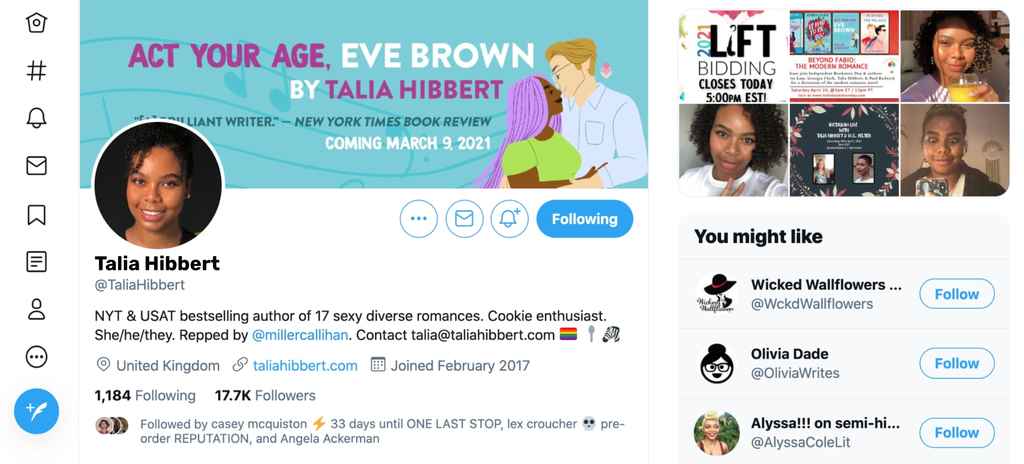 Talia Hibbert, author of multiple bestselling romance novels, does a fantastic job of promoting their work and engaging with their followers in an authentic way. In terms of presentation, Hibbert’s profile picture is a smiling close-up, their header features the eye-catching cover of their newest release, and their bio is the perfect blend of playful and informative:
Talia Hibbert, author of multiple bestselling romance novels, does a fantastic job of promoting their work and engaging with their followers in an authentic way. In terms of presentation, Hibbert’s profile picture is a smiling close-up, their header features the eye-catching cover of their newest release, and their bio is the perfect blend of playful and informative:
NYT & USAT bestselling author of 17 sexy diverse romances. Cookie enthusiast. She/he/they. Repped by @millercallihan. Contact talia@taliahibbert.com 🏳️🌈 🥄 🦓
Looking through their Tweets, you’ll see they clearly love their readers and express joyous appreciation for compliments and fanworks (such as these Spotify playlists made by a fan for each of the Brown Sisters romances). However, Hibbert doesn’t limit themselves to reader interactions and book talk, also posting thoughtfully about social issues — such as how to combat racism and ableism — as well as the occasional funny video, exemplifying just the right balance for any 21st century author.
Instagram for authors
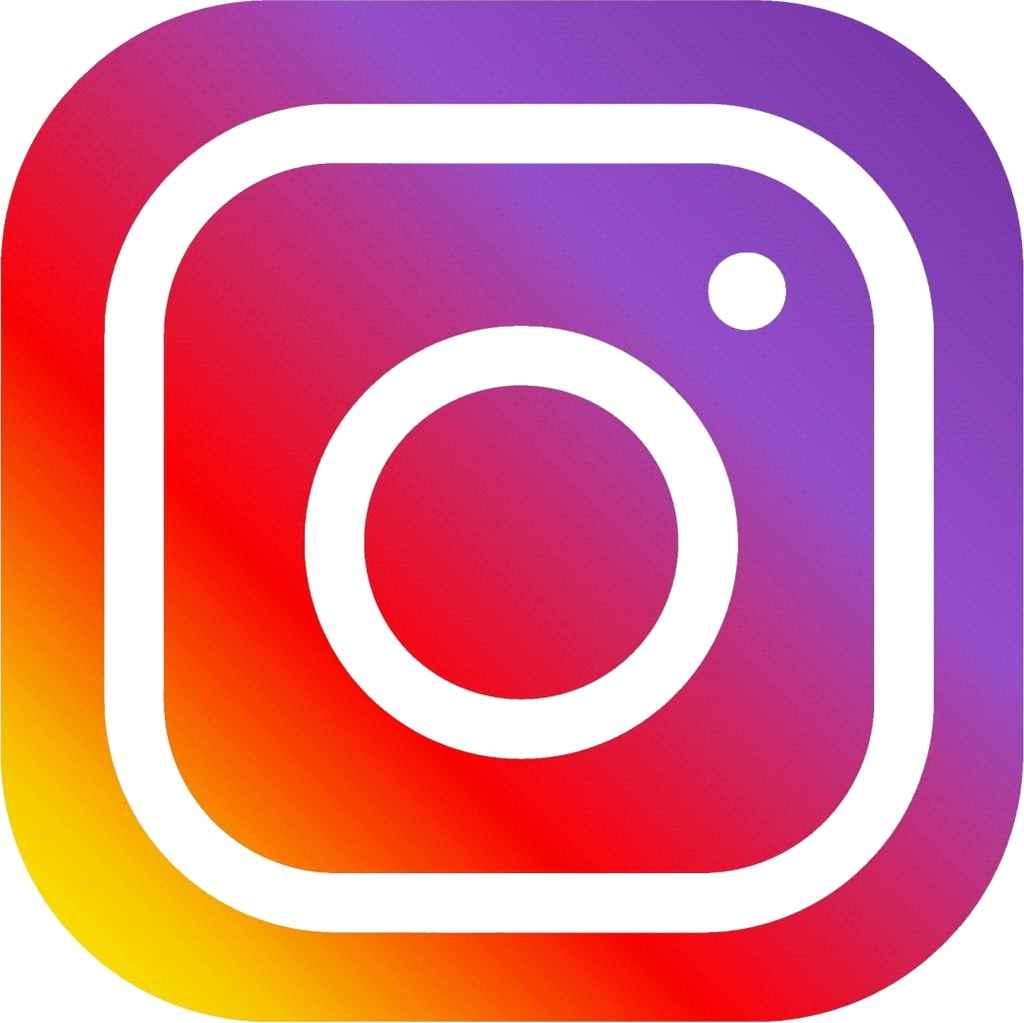
For writers looking to stay hip with the youths (we hope the irony of this sentence is self-evident), a carefully cultivated Instagram account is a must. The good news is that Instagram is actually pretty easy to access and use, and you definitely don’t need to be posting on all of Instagram’s different channels constantly.
For those who are hazy on these features, here’s a quick rundown:
- Posts are the good old-fashioned content Instagram’s always had. Most accounts publish 2-3 posts per week, which appear on the main Instagram feed and their profiles.
- Stories are temporary pieces of content that appear for only 24 hours. In addition to images and videos, authors can also post interactive content like polls, quizzes, and countdowns (to your big release date for example). You can also create Story Highlights that remain on your profile permanently, for important topics where you have more than 10 pieces of content to share (10 is the limit for regular posts).
- Reels are a recent addition to Instagram, allowing users to create snappy videos up to 30 seconds each, in the vein of TikTok.
- IGTV is for longer, more thoughtfully produced video content — Q&As, in-depth commentary, etc. — that runs 1-15 minutes long. These videos appear under the IGTV tab on your profile, and you can even add them to an ongoing series on a topic.
- Finally, Guides are lengthy Story-like content that users can tap through to get information on a topic. Guide Types include Places, Products, and Posts — so for example, if you had done setting research for a book, you might promote it by posting a Place Guide to that area.
Now that you (hopefully) understand the five major forms of Instagram content, let’s talk specific tactics for writers.
Tips for authors on Instagram
🤓 Think reader-first. Instagram is a reader’s paradise, #bookstagram being the massive subculture that it is. So while you can connect with fellow authors on IG, you’ll want to tailor your strategy more to readers. Consider creating videos, Story Highlights, Guides that tie into literary content, and relate them back to your own work in a fun way!
🎁 Host giveaways. On a similar note, Instagram is the perfect place to do giveaways: people get a clear visual sense of what you’re offering, and you’ll likely gain quite a few followers and comments because engagement is so high. Try offering up a free copy of your book, another author’s book, or whatever your followers are interested in.
📖 Make the most of Stories. Many people underestimate Stories, but they’re the best way to build a rapport with your followers! Again, any kind of interactive content is good for this. Consider creating Story templates so your Stories have an immediately recognizable brand, and remember to save your best ones as Story Highlights.
💯 Above all, keep it real. Instagram has a reputation for being “fake” — what with all the heavily edited photos, ghostwritten captions, etc. — so it’s best to sidestep the label, unilateral and untrue though it is, by being as earnest as possible. Give your followers what they really want: to get to know the real you!
Case study: Jia Tolentino
 One person you should definitely be following on Instagram is Jia Tolentino. For those who don’t know, she literally wrote the book on the pitfalls of digital self-delusion, so it makes sense that her online presence would be refreshingly genuine and lovely.
One person you should definitely be following on Instagram is Jia Tolentino. For those who don’t know, she literally wrote the book on the pitfalls of digital self-delusion, so it makes sense that her online presence would be refreshingly genuine and lovely.
Indeed, though Tolentino posts her fair share of impressive photos, her feed and Stories never feel overly polished or pretentious. She balances professional news and topical content with personal updates, allowing readers to feel informed on both popular culture and her actual life.
Observant 'grammers will also note that Tolentino doesn’t use IGTV or Reels — proof that you don’t need to use every feature on a social platform in order to succeed. If you’d rather focus on day-to-day snapshots and eloquent captions, you have our permission to stick to your strengths.

FREE COURSE
Book Marketing 101
Learn seven tried-and-true strategies for boosting book sales.
Pinterest for authors
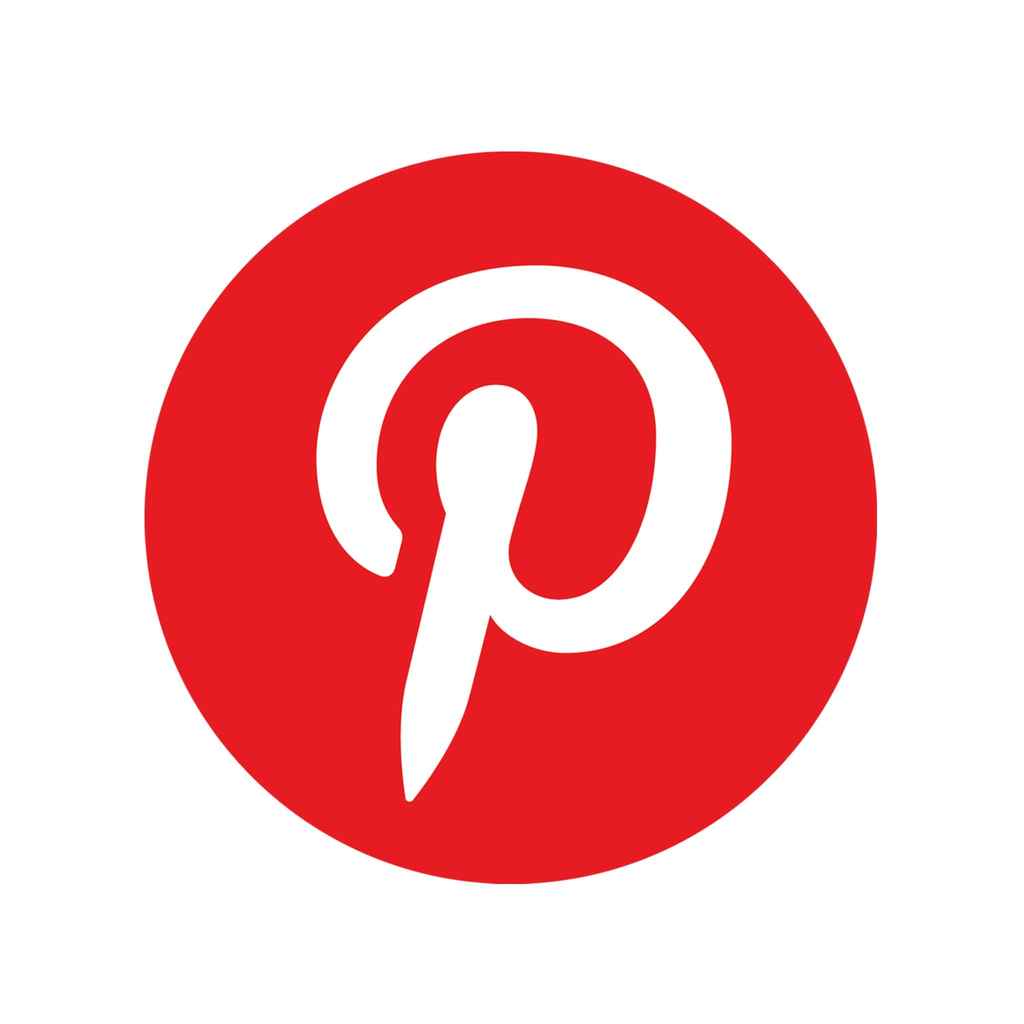
Ah, Pinterest: a haven for the craft- and literature-obsessed alike. This platform, which allows you to create your own themed virtual corkboards, has been described as a “non-social” social network: most users just make their boards and add to them independently, without needing to interact with other users.
As a result, Pinterest is the ideal platform for authors who want to tap into readers’ cravings for visual content — as they might on Instagram — but without the pressure of having to constantly engage. And as you might expect, Pinterest works best for writers whose works have a distinctive aesthetic, especially science fiction and fantasy stories. It’s a marvelous platform for bringing your vision to life, allowing you to choose from a vast ocean of possibilities.
If that sounds right up your alley, here are some tips to give you the Pinterest assist!
Tips for authors on Pinterest
💼 Get a Business account. It’s free to convert your regular Pinterest account into a Business account, and it offers many useful features: analytics, ad management, and more. Even if you only intend to use Pinterest casually, it’s still worth getting the free Business account, as it allows you to have a cover photo.
📌 Use Rich Pins for products and articles. Rich Pins are Pins with data attached that click through to an external page, like the sales page for your book or a blog post you’ve written. Rich Pins are great for previewing content you’ve posted elsewhere, and many authors use them to promote their free and discounted books!
📥 Pay attention to your inbox. Though Pinterest isn’t nearly as demanding as other social platforms, users are able to message you and send you Pins. Check your inbox (Pinbox?) once a week, just to be sure you’re not missing anything.
🎉 Have fun with it! Business features notwithstanding, as an author you probably won’t do most of your business on Pinterest — so have fun experimenting with different Pins, and don’t be shy about adding new content to your boards. Even if you can’t articulate why you like a certain Pin, better to save it now so you can find it again later.
Case study: Leigh Bardugo
 Leigh Bardugo is clearly on top of her Pinterest game, and anyone who’s read her “Tsarpunk” Grishaverse books will recognize their aesthetics, settings, and themes in these Pins. From bespoke boards for her stories The Demon in the Wood and The Language of Thorns to boards for Russian-inspired clothing and places, Bardugo’s Pinterest content provides both inspiration for her as an author and insight for readers into her process.
Leigh Bardugo is clearly on top of her Pinterest game, and anyone who’s read her “Tsarpunk” Grishaverse books will recognize their aesthetics, settings, and themes in these Pins. From bespoke boards for her stories The Demon in the Wood and The Language of Thorns to boards for Russian-inspired clothing and places, Bardugo’s Pinterest content provides both inspiration for her as an author and insight for readers into her process.
Note, however, that she doesn’t force herself to stick solely to literary aesthetics, and has an extensive board of home decor ideas as well. Like Twitter, Pinterest is a great place to try new things; take your cue from Bardugo and pin whatever strikes your fancy. Even if it’s not related to your writing, readers will enjoy the sneak peek into your personal life.
Other social platforms
Facebook, Twitter, Instagram, and Pinterest are the biggest author-friendly social media platforms, but they’re not the only ones out there. Here are five more slightly “niche” platforms you might consider and what they have to offer writers.
🧭 Reedsy Discovery
Reedsy Discovery is a book review, recommendation, and discussion platform that’s perfect for the literary-minded. As an author, you can submit your book for review and receive a customizable author page to help promote your book, post personal updates (including reader polls and book recommendations), and keep track of who you interact with on the platform.
It’s a fantastic place to connect both with other authors (especially indie authors!) and with readers, who enjoy the cutting-edge recommendations and meaningful engagement over what they love most: books. Discovery is definitely a boon for authors who want readers' eyes and early reviews, and for readers who crave connection and smooth functionality in their social reading platforms (compared to, say, the next site on this list).
Sound intriguing? Click here to learn more about submitting your book to Reedsy Discovery.
📚 Goodreads
Every author should claim their profile and books on Goodreads for verification purposes, but you might consider using Goodreads for social media as well. Its key advantage, like Discovery, is that it’s tailored to authors and readers. Readers can also see when you add any information about your upcoming book(s), as well as any reviews you write.
The downside is that it takes a lot of work to build your following on Goodreads alone. Roxane Gay, for example, has managed it by releasing several books and writing tons of reviews… but her circumstances, by her own admission, are unusually conducive to productivity.
This is why we generally recommend having Goodreads as an author and posting occasional updates, but not making it one of your primary social platforms, as most authors will find it’s too much work. Still, if you love writing book reviews, it could be worth a shot!
👩🏻💻 Tumblr
Tumblr is the classic “fandom” platform: a place where people have long congregated to celebrate their favorite TV shows, movies, and of course, books. Many well-known authors have maintained their own Tumblr accounts over the years, reblogging Pinterest-like aesthetic posts, talking about their writing, and responding to lucky fans (leading to occasional gems like this.)
Tumblr has recently fallen by the wayside but there’s still a strong fan presence on the site. If you already use Tumblr, definitely try posting your own work for your followers; it could be the perfect opportunity to gain relevant readers. And even if you’re starting fresh on Tumblr, you can try getting involved in fandoms yourself — if nothing else, you’ll meet a ton of people who are similarly passionate about books.
📺 YouTube
You might think we’d have mentioned YouTube earlier in this guide, given its substantial user base. But truth be told, it’s not an ideal social network for most authors, mainly because it’s tough to churn out consistently engaging long-form videos about your writing.
That said, it’s great for readers — by which we mean BookTubers and the people who watch them. As on Goodreads, if you love reviewing books, you might try to build a YouTube following based on that. But you probably won’t have much luck coming at it solely from a writer’s perspective — not to mention that producing regular YouTube videos takes a ridiculous amount of work, much more than just snapping a few Stories a day.
👯♀️ TikTok
If you’re interested in creating videos to boost your brand, TikTok might be your best bet: it’s the latest platform designed for creative short-form video content, and it’s blown up over the past couple of years. While most popular content remains wacky and meme-based, BookTok is a steadily growing faction that could easily become the literary hub of the future.
For now, TikTok remains in the same category as YouTube — good for readers, not so much for writers — but it’s worth keeping an eye on, and could be fun to experiment with as an author. By nature of its novelty, whatever you do as a writer on TikTok will be breaking new ground; if you get it right, you could become one of the platform’s pioneers.
Running ads on social media
Finally, if maintaining an organic social media presence of any kind feels like a lot of work (which, to be fair, it is!), consider taking the “organic” part out of the equation and instead creating paid ads on social media to help new readers find your books.
Running ads on Facebook is one of the best ways for authors looking to acquire readers they otherwise wouldn’t be able to reach. We recommend taking this free course on Facebook ads, which will take you through everything you need to know about the platform for ad-using authors. Or you can expand your range by advertising on Amazon ads and BookBub ads for your book — both of which are excellent for targeted ads, as the people on those platforms are already looking for new things to read!
Whether you aim for organic growth or paid ads on social media, it will take some work to succeed. But once you find the right platform(s), get situated within your niche, and maybe even start making some friends, you should find it’s not so much a drag as an exciting new challenge — and could even turn into a lifelong hobby. Here’s to you and your book going viral! 🥂

